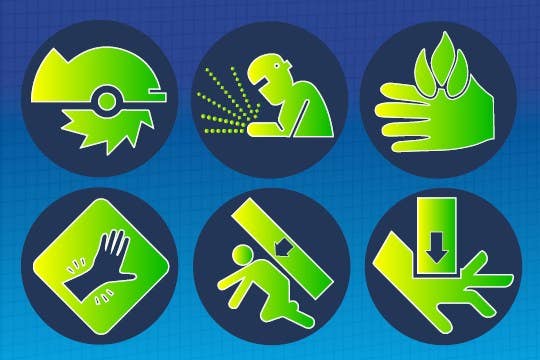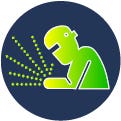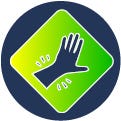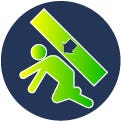
6 Safety Tips for Machine Guarding and Beyond
By John Heniff, Safety Writer, Magid
According to OSHA, approximately 18,000 machine operators and maintenance workers suffer debilitating injuries every year. Diving deeper, 800 of these workers die while operating machines. Whether your workers are involved in woodworking, mechanics, forge work, or general industry, knowing the ins-and-outs of how to protect themselves while operating machines can be the difference between a good day at work and a life-changing tragedy.


MACHINE GUARDS
Machine guards come in all shapes and sizes, from gates and restraints for welding or shipping areas to pressure sensitive monitors and two-hand controls on cutting machines. Some workers may think they look unnecessary or “get in the way” of the job, but you can remind them in safety trainings that their ultimate purpose is to make sure they have an extra level of protection from any moveable hazards that can injure them.
BEYOND MACHINE GUARDING
Even with proper machine guards in place, workers can always use a refresher on how they work and the safest practices for using specific machines and equipment. Safety trainings and short safety reminders in the form of posters and videos can keep workers aware of how to be extra careful when using power saws, milling machines, power presses, and other common machine-guarded tools.


HERE ARE 6 COMMON HAZARDS WORKERS NEED TO BE
AWARE OF WHILE OPERATING MACHINES ON THE JOB


1. Cuts & Lacerations
Sharp objects like sawblades or stationary objects spinning on a lathe are only inches away from their hands and fingers.
INJURY PREVENTION:
- Replace dull blades so workers don’t have to apply more force than necessary and risk a slip.
- Use push sticks, hand-feeding tools, and automatic or semi-automatic feeding to keep hands clear of blades.
- Clean up work areas so sharp materials are not left in the open.


2. Projectiles
Whether it’s wood chips from a lathe, sparks from a metal grinder, or splashes or sprays from chemicals, projectiles can disorient, injure, or even blind a worker.
INJURY PREVENTION:
- Install machine guards between workers and any projectile materials where possible.
- Secure movable equipment like sawblades and belts when not in use.
- Wear proper PPE like safety glasses and face shields.


3. Burns
Machines that create heat like ovens can have exposed hot surfaces that can cause a burn upon contact.
INJURY PREVENTION:
- Wear heat and flame-resistant PPE.
- Set up extra guards to prevent workers from coming into contact with or reaching over hot surfaces.


4. Snags & Pinches
Rotating machines like drill presses, lathes, mills, and band saws can pose a snag threat in that they can hook and grab loose clothing or jewelry. Nip points, also known as pinch points, can also grab loose items if a proper barrier guard is not in place, dragging a worker in and potentially causing an abrasion or a more serious injury. Extreme caution must be taken to avoid gloves, loose clothing, and other PPE from becoming entangled in rotary tools, possibly leading to serious injury to the operator.
INJURY PREVENTION:
- Remind workers to check that their clothing is tight and neat.
- Remove loose jewelry and gloves.
- Tighten sleeves.
- Pull back loose shirts or garments to create distance between pinch and snag hazards.


5. Crushes
Another danger of pinch hazards, especially with machines that have presses and rolls, is the potential of an unguarded machine pulling a worker in and crushing their fingers or hands.
INJURY PREVENTION:
- Be aware of crush hazards in the work area beyond machines like falling objects, vehicles, heavy machines with moving objects, etc.
- Stay away from loose and heavy objects that could break and suddenly fall like a heavy box or crate.
- Use guard-opening scales, restraints, or other machine guards to ensure employees cannot put their hands at risk.
- Use push sticks, hand-feeding tools, and automatic or semi-automatic feeding to keep hands protected.


6. Amputations
One of the most dangerous and traumatic injuries a worker can suffer is the loss of a limb. The Bureau of Labor Statistics stated that over half of workplace amputations in 2018 that were nonfatal involved some kind of machinery, mostly from metal and woodworking machines.
INJURY PREVENTION:
- Utilize lockout/tagout procedures.
- Require workers to have both hands on machine controls during use.
- Install a barrier to protect workers from dangerous areas.
GENERAL SAFETY TIPS FOR MACHINE SAFETY
After you have documented and shown off your jobsite’s machine guards to your team, use these management tips to prepare them for the next time they go to their workstation.
- Have an onsite safety talk to prepare workers for any hazards they may encounter on machines they’ll be working on that day. Remind them how certain machines work and what kind of safeguards they use.
- Assign new workers a mentor to show them how to properly use a machine and see the machine guards that come with it. Think about having retiring workers pass on their knowledge in these instances, too.
- Train workers to inspect the machines they will be using and the safeguards protecting them before use.
- Train workers to report a problem with a machine or any safeguards that are inefficient or broken.
- Emphasize a “safety first” mindset rather than a “getting the job done at any cost” mindset.


Keep your crew thinking about safety throughout the day. Get FREE safety reminder posters to hang around your workplace!



